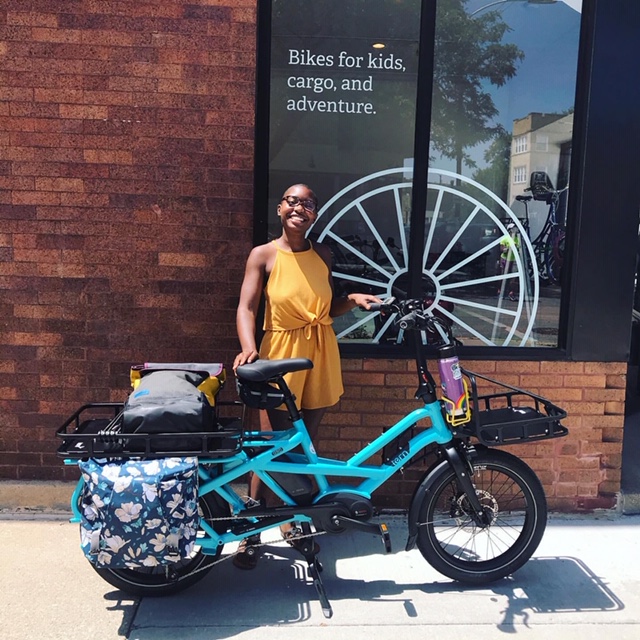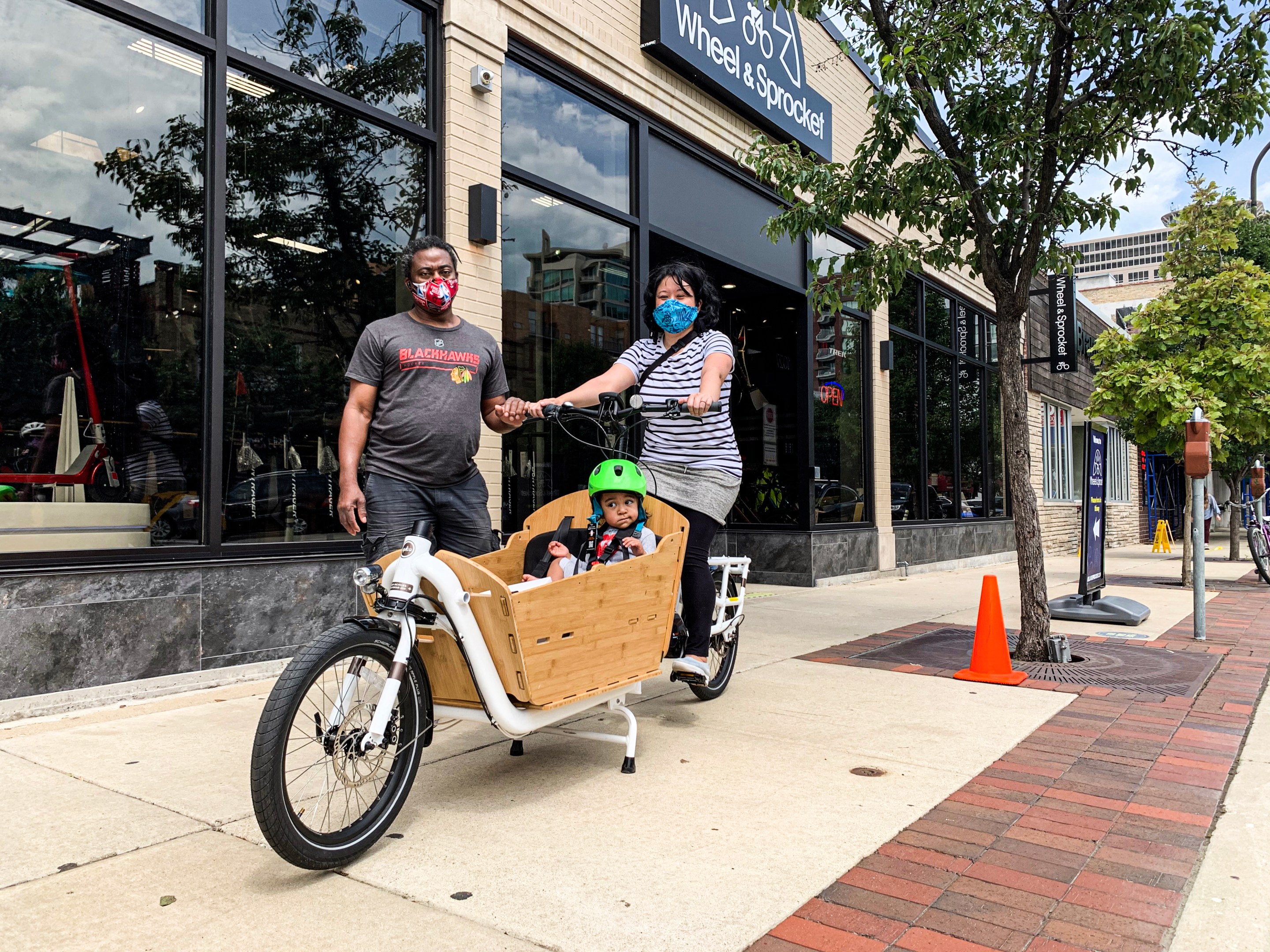During the pandemic, we've seen a national biking boom as people seek socially-distanced ways to get around, get physical activity, and have fun, and Chicago is no exception. I am definitely seeing more people biking on the North Side this summer than I did last last year. This summer I joined the ranks of e-bike owners after my non-electric bike was stolen. I was already interested in these bikes and becoming an owner has inspired a research binge.
Unsurprisingly, e-bike sales have soared along with traditional bikes during COVID-19. According to bike industry market analysis, electric bike sales were up 84 percent in March, 92 percent in April, and 137 percent in May. Chicagoland bike shops report they’re generally seeing an increase in sales, including e-bikes, due to the pandemic.
Eric Krzystofiak, general manager for Wheel & Sprocket in Evanston and Oak Park says he doesn't expect the increase in e-bike sales to slow down anytime soon. "Our customers haven’t experienced any delays in getting the bike they want. As more and more people find out they can replace a car and get a good workout with an e-bike, we expect the popularity to continue to grow.”
I checked in with new e-bike owners to hear about their experiences. Sarah Sweet and her husband and son lives in Ravenswood. They were considering buying an electric car but found there weren’t a lot of affordable options. Her husband found Four Star Family Cyclery and suggested they test ride bikes. After renting a bike for a weekend and testing it out with their son, they were sold.
Sweet said before discovering e-bikes she never felt all that safe and comfortable biking. “We were getting kind of bored with walks and the bike just opened up our world. We haven’t driven our car in the 2 months we’ve had the e-bike.” After buying an e-bike, Sweet is more vocal about her desire for protected bike lanes and secure bike parking at her workplace. She says people ask her questions about her bike on a daily basis. “Most people are interested in the electric part. ‘Is there a motor? Do you pedal? How do you park it? How often do you charge it?’ I get a lot of interest at the farmer’s market. It’s fun!”
Christine Velez lives in Streeterville with her husband and her two-year-old daughter. She purchased her e-bike in response to unreliable transit access due to the Mayor Lori Lightfoots’s transit shutdowns during recent civil unrest, and hopes rides with her daughter will provide a new source of sensory stimulation. When it comes to storing her bike, she’s fortunate enough to live in a building with a dedicated bike storage room on the ground floor, and it is equipped with monitored cameras. For Chicagoans without access to such amenities, the city would do well to create more secure on-street parking on residential streets. I mentioned this in my article, “How Can Chicago Support the e-bike Revolution?”

Steven Quispe of Albany Park purchased his VanMoof e-bike with stimulus funds in April. “The big appeal for an e-bike was being able to go longer distances without being super sweaty," he said. "Being able to easily bike on a super windy day was also a big appeal.” I asked Steven if he had any memorable rides in windy conditions. He said he was actually out biking the day Chicago experienced tornadoes! “I did slide a little bit but it wasn’t as bad compared to if I had been on a regular bike.”
Quispe discussed some of the responses to his bike. “The most common reaction is people thinking it’s unlocked." Quispe’s bike has a built-in kick lock. You activate the kick lock by aligning the wheel to a marked spot and kicking the lock in with your toe. This freezes the rear wheel until the bike owner unlocks it with an app or a passcode. There are also GPS capabilities embedded in the bike which allow the owner to see where it is. In the event the bike is stolen, VanMoof sends out folks to track the bike down.
"I’ve had about five theft attempts and a few of my co-workers have assumed I’ve been absent-minded by not locking my bike up,” Quispe said. He shared a story of a concerned citizen reporting his bike as abandoned. Steven received an alert that his bike was being tampered with and found Chicago Police in the process of hauling it away. He was able to show that he was the owner of the bike and police encouraged him to lock it up.
Asked what changes he’s noticed in his biking experience as a result of being able to go faster. “I can now beat the Brown Line from my home to the Loop. Biking saves me about 10-15 minutes. I’m also going on longer rides.” Research has shown e-bike riders ride longer distances than those riding a traditional bike.
Asked about interactions with drivers, Steven noted that drivers are not being used to encountering someone on a bike riding so fast, which is something I can relate to. We have both had experiences with drivers making turns in front of us that forced us to brake quickly to avoid a crash. I’ve had some motorists attempt to change lanes and be surprised by my speed.
My last interview was with Martha and Margaret, a couple who live in Ravenswood along with their two children. Margaret was in need of a new bike because a bike she was given at age 14 was ready to be retired. The couple was also uncomfortable riding the CTA during the pandemic. They also love being outside during the warmer months and felt biking could increase their enjoyment of the outdoors.

Martha and Margaret find their electric cargo bike to be an improvement over transporting their children by bike trailer. They can keep a better eye on their children, since they're not riding in an enclosed space, and they no longer have to yell in order to communicate.
Asked if there’s anything the city could do to support e-bike owners or cycling in general, Margaret responded, “Oh my gosh! I’d love more protected bike lanes across the city. I don’t like having to research my route before going somewhere. A lot of the bike lanes in our areas are on busy streets.”
Martha and Margaret praised the Leland Slow Street in their neighborhood, and the parking-protected bike lane on Broadway, and said they would like to see more of them. They did have some complaints about dockless e-scooters taking up space at the bike racks. “People are riding their bikes more during the pandemic, so we need more bike racks. The scooter companies should have to pay to [install] more bike racks if their products are going to be using the space.”
The pandemic bike boom could have been an opportunity to upgrade bicycling facilities for all bike riders, not just e-bike owners. I’m seeing more riders on the streets, and they’re all biking in spite of the sub-par infrastructure. It would be wonderful if CDOT was out counting the number of cyclists out on the street and making the case for protected lanes. Imagine how many more folks would ride if we had bicycling facilities that prevented driver-cyclist crashes and stopped people from parking or driving in the space meant for biking. Along with a desire for more protected lanes, I would like to see the city invest in e-bike charging infrastructure. There’s been a lot of movement to ensure electric car owners have access to charging stations, and we should do the same for electric bikes. It would be nice to see charging stations along the Lakefront Path, at Chicago Public Library locations, and at major transit hubs.
I’m excited to see more people out on e-bikes. I’ve been casually noticing a few here and there when I’m out. Some of the folks interviewed mentioned that because of their e-bike purchase, some co-workers and neighbors have looked into buying an e-bike. I’m sure the Divvy e-bikes will also increase folks’ interest in owning an e-bike. Government subsidies for the purchase of e-bikes would also be a welcome addition to the sustainable transportation landscape here in Chicago.
Follow Courtney Cobbs on Twitter at @CourtneyCyclez.




